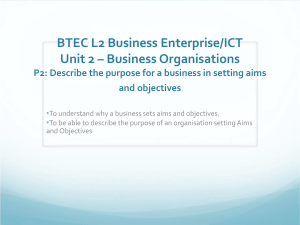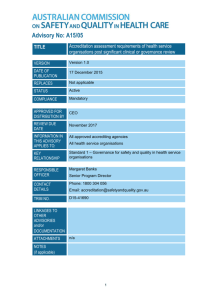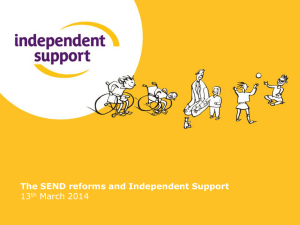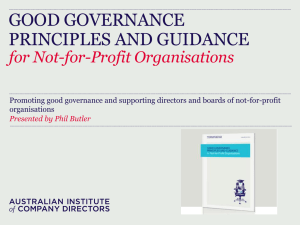Shared back-of-house services - Department of Human Services
advertisement
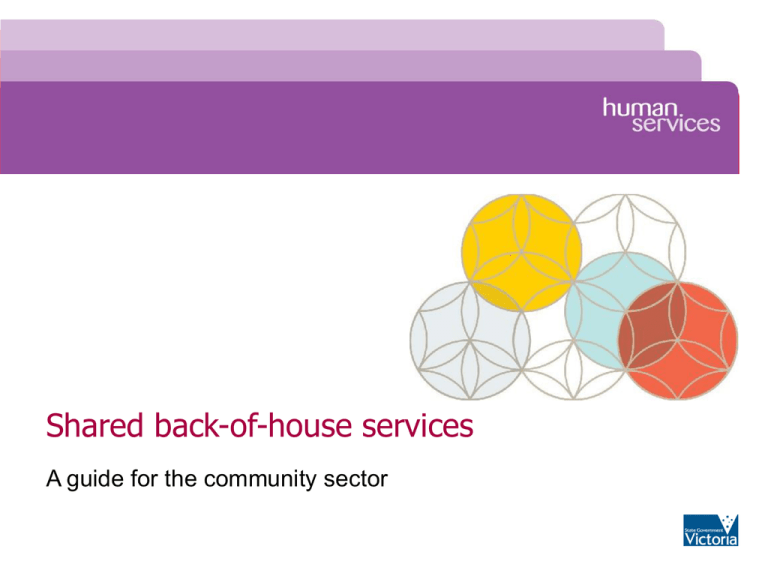
Shared back-of-house services A guide for the community sector Objectives of the workshop • Inform: Present information on shared services in the NFP sector • Share: Draw on the group’s experience to understand: ▪ Why organisations undertake shared services ▪ What does and doesn’t work ▪ How to test if shared services are right for you ▪ How to undertake the transition • Brainstorm: Identify opportunities to overcome barriers to implementing shared services Slide 2 Your objectives for the workshop • Horizontal axis: how experienced is your organisation with shared services. • Vertical axis: how prepared are you to undertake the change. Slide 3 Agenda • Part 1 • Session 1: Information session (30 mins) Different models and advantages & disadvantages of shared services • Session 2: Working session (60 mins) Why consider shared services BREAK • Part 2 • Session 3: Working session (45 mins) How to assess the feasibility of shared services • Session 4: Working session (45 mins) How to implement shared services Slide 4 What are shared services? • Shared services involves two or more organisations working together to jointly manage and/or deliver services. Benefits can include greater efficiencies in back-of-house services through economies of scale, making better use of skilled and physical resources or reducing risk. • Back-of-house services include any service that does not directly support clients – for example, human resources, finance, payroll, information and communications technology (ICT), marketing, procurement, legal advice, etc. Slide 5 The shared services test How do we know if a arrangement is shared services? What matters is the intent of the arrangement and/or the existence of a joint governance arrangement. If the arrangement is shared services, your response should be yes to at least two of the following questions: Is the intent of the arrangement to create mutual benefits for two or more organisations? Will the benefits (or problems) of the shared services arrangement be shared between organisations? Does shared governance arrangements allow clients or staff who receive the services to influence or control the design, management or delivery the back-of-house services? Slide 6 Types of shared services There is a continuum of shared service governance arrangements. Model 1: Advice and support network Simple Model 3: Traditional provider/ supplier (within existing organisation) Model 2: Shared personnel, asset or facilities service Complex Model 4: Managed Service Organisation Outsource implementation Implementation steps Informal governance arrangements Formal governance arrangements You need to match the formality of governance arrangements with the importance of the service being shared.…BUT this may not be the case with all arrangements – trust and relationships play a factor. Slide 7 Motivations for considering shared services Slide 8 Working session: what are the challenges and barriers to shared services? Instructions: 1. Individually, on A4 sheets of paper, write down the top two barriers you think organisations face to implement shared services. 2. In table groups, share your barriers to shared services. The goal is for each table to identify three common challenges. 3. As a group, discuss the challenges and barriers. 4. As a group, discuss possible mitigation strategies. Slide 9 Common lessons Challenges and mitigation strategies: 1. It takes time to implement change and it won't happen overnight 2. Change often brings anxieties and resistance from staff. Careful change management is necessary from the outset. 3. Not all organisations have the trust and relationship networks that are necessary for shared services. 4. Collaboration does raise the potential for conflict. It needs to be set up for success with clear governance. Slide 10 Next steps and break • Shared services offer a lot of promise for the NFP sector. • Implementing a new back-of-house service delivery model will require investment and careful consideration of the benefits. • After the break we will be discussing: a. how to assess the feasibility of shared services b. how to implement shared services. Slide 11 Assess the value and feasibility of shared services There are two threshold questions to determine the benefits of shared services for each organisation. 1. The first is will there be any tangible value from transitioning to shared services? 2. If there will be value in shared services the second hurdle is does your organisation and your potential partner(s) have sufficient resources and motivation to make the transition feasible? Slide 12 1. Will shared services offer value? Use self-evaluation form to assess your organisation’s: 1. Efficiency and effectiveness of existing services? 2. Operating environment changing? (e.g. NDIS) 3. Could increasing scale increase the expertise of your team? (e.g. employing a highly skilled HR manager is difficult only 1-2 days per week) After reflecting individually for 5 minutes, discuss in table groups for 5 minutes. Slide 13 2. Are shared services feasible? Use self-evaluation form to determine: 1. Do you have strong working relationships with organisations you can partner with? 2. Do you have the expertise to manage the transition? 3. Are your management committed to the change? After reflecting individually for 5 minutes, discuss in table groups for 5 minutes. Slide 14 How to strengthen the feasibility of shared services – suggested steps • Relationships and trust • • • Build relationships with NFPs with similar vision, mission Start small and build trust through collaboration Have upfront discussion about strategic need to partner • Access to expertise • • Undertake market scan to identify relevant expertise Develop cost benefit analysis for skilled advisers to implement shared services • Management commitment • • • Develop business case and risk management plan Demonstrate alignment of shared services to strategic plan Undertake market scan to identify how similar organisations are sharing services Slide 15 Implementation planning Careful planning will be critical to the success. The basic steps are: 1. Scope options 2. Develop business case 3. Implement Change management Key points: • Implementation steps will differ depending on the model of shared services. • Governance arrangements should manage the risks associated with the services being shared. • Change management needs to start early and be delivered throughout. Slide 16 Step One: Scope options for shared services 1. Scope options 2. Develop business case 3. Implement The key questions to answer in this stage are: 1. 2. 3. 4. 5. Why shared services? Confirm your mutual understanding and drivers. What services will be shared? What activities are in and out of scope? What is the level of service required? What do you want to change/improve about existing services? Slide 17 Step Two: Develop business case for establishing shared services 1. Scope options 2. Develop business case 3. Implement The key steps in developing a business case are: • • • • • Identify the benefits of the project Identify the implementation and ongoing costs Determine success factors and risks Confirm the governance arrangements Develop a project plan with detailed accountabilities Slide 18 Step Three: Implement shared servies 1. Scope options 2. Develop business case 3. Implement The key to successful implementation is: • • • • • Clearly defined roles, including project management and allocated activities Schedule milestones and develop a monitoring and reporting schedule Set performance targets Develop a communication strategy Identify and manage risk factors Slide 19 Involvement and ownership Change management process Build awareness Define where we are going and why Deepen understanding Equip and activate leaders to drive change Create buy-in Use leverage and engagement at scale to build critical mass Take action Embed and sustain the change Make it stick Build and mobilise Engage for action Set direction Elapsed time The time frame required to manage change will increase as the complexity of the shared service arrangements increase Slide 20 Next steps and available resources 1. http://www.dhs.vic.gov.au/for-business-and-community/not-for-profitorganisations/publications-for-community-organisations: Get a copy of the Shared Services Guide and access a range of other resources for community organisations. 2. www.nfpcompliance.vic.gov.au: The Not for Profit Compliance Support Centre is an online information resource for Victorian not for profit organisations to assist them to comply with their regulatory requirements. 3. http://sspproject.wikispaces.com/: Online resource developed by Adult Community Education Sector in Victoria in response to the Skills Victoria reforms. This website includes guidance on undertaking shared services projects, lessons learnt and project templates. 4. www.nfpbenchmarking.com.au: A three year study by thirteen not-for-profit organisations in Victoria to benchmark the cost and quality of six back of house services. Slide 21

